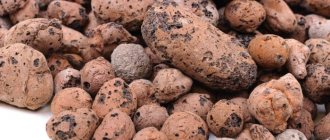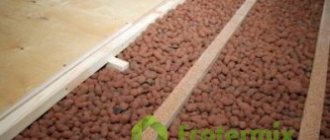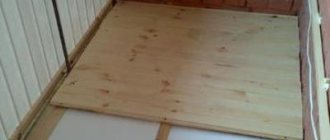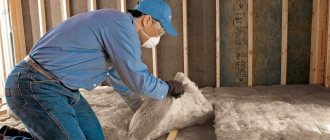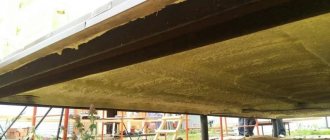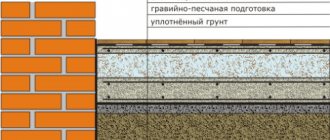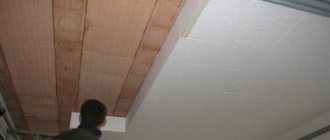Now, more than ever, home insulation products are becoming popular. This is not surprising, because people realized that heat should not be generated, but stored. Due to heat loss, heating costs become quite high. That's why many people resort to insulation. And it is right. One of these materials, which is the personification of simplicity, environmental friendliness and durability, is expanded clay. It solves several problems in construction: it insulates and levels the surface. It is used not only for horizontal surfaces. They can also insulate walls. The material is universal and has won many positive reviews.
In this article we will get acquainted with this insulation, find out the properties, advantages and disadvantages, consider how to insulate a floor with expanded clay, and also read the statements and reviews of those who have already used this insulation. This will help you understand what expanded clay is like as a floor insulation material.
The principle of operation of insulation
Many people know that the most effective thermal insulation material is air. Along with it there is only inert gas, which almost does not react to the environment. It is this gas that is used to fill the glass unit chamber. However, you cannot use it for building structures (floor, walls, ceiling), since absolute tightness is required.
Almost all materials for thermal insulation have a porous structure. Due to this, there is air in the pores, which inhibits heat loss. There is a certain pattern: a less dense material has better thermal insulation properties than a dense one. The lower the density, the better the insulation.
All insulation materials can be divided into several types:
- roll;
- slab;
- bulk;
- sprayable.
The most budget-friendly is the sprayed type of insulation, which includes expanded clay. The fact is that this type of material has almost the lowest thermal protection indicators. But it can insulate the structure. Why do you need thermal insulation at all? Look at the photo to find out.
Insulation work solves at least 4 problems:
- Provides a reduction in budget waste on heating the house.
- They protect the structure from condensation, which serves as a source of fungus and mold.
- They create comfort, warmth and coziness in the house.
- Gives the room soundproofing properties.
If you do not insulate your house, its operation will bring you many problems. What can we say about expanded clay as an insulation material?
Possible situations
It’s easy to insulate a house from the outside using expanded clay concrete, knowing the two main options for laying expanded clay concrete block
It is important to study each one to choose the best one for your home.
There is no external façade cladding
This means that there is nothing except two rows of expanded clay concrete blocks. There are no external façade materials at all. In such a situation, when cladding a building with brick, it is possible to place insulation between the cladding and expanded clay concrete.
This is an effective thermal insulation measure, but it is used quite rarely. And all because the material for cladding the entire house will not be cheap. In addition, it is difficult to carry out such a volume of work on insulation with this material yourself. Because of this, you have to resort to outside help, which also costs additional costs.
More budget-friendly insulation options are made using panels. For example, lining, metal or plastic siding. Insulation in such situations is often polystyrene foam. This material is laid in two layers, provided that it is 5 cm thick. The panels are placed on expanded clay concrete so that the seams of the first layer do not meet the second. Next, siding is laid, and a vertical profile is placed under it, which forms the frame.
In addition to foam panels, mineral or basalt wool is used. But such materials require protection in the form of a vapor barrier. A glued slab heat-insulating layer is also used, and then covered with plaster. Plate insulation - polystyrene foam, polystyrene foam or penoplex. Easily attached to expanded clay concrete and then secured with dowels.
Facade with facing bricks
A fairly common situation when purchasing an unfinished building.
Such a house already has a brick cladding, but there is no insulating layer between it and the kerazito-concrete one. To correct the situation, the walls are treated with polyurethane foam. This action is performed using holes in the wall through which the mixture is supplied. The polyurethane in these holes expands and fills the gaps. With such insulation, the expanded clay concrete house is protected from moisture, rodents, and mold. The only disadvantage of this procedure is the price. In addition, specialists are needed to lay down this material, which also entails additional costs.
Advantages and disadvantages of expanded clay
Expanded clay is a porous material that is produced by firing clay or shale. Look at the photo to see what it looks like.
And if it is not recommended to use expanded clay for multi-storey apartments, then for a private house it is a good option. Why can you say this? Look at the benefits of expanded clay:
- The insulation is very easy to install with your own hands.
- The material is inexpensive, so everyone can buy it.
- It is suitable for insulation inside, as it is environmentally friendly.
- Expanded clay creates an even base for the floor cake.
- The material is not afraid of temperature changes, does not rot or burn.
- Rodents do not touch it.
- Insulation is used for floors that will be subject to heavy loads. Indispensable for industrial premises.
If we talk about the disadvantages of expanded clay, the main one is its lower thermal insulation ability. If we compare expanded clay with the same polystyrene foam or mineral wool, they retain heat better. The photo shows this difference.
Therefore, when insulating, you need to correctly calculate the thickness of the material. Since bulk insulation has a thermal conductivity coefficient that is twice as large, the layer of material must be doubled to obtain the desired result. Basically, the thickness of the expanded clay layer is 200 mm. This is the best option.
Note! The negative point of insulation is its low moisture resistance. Therefore, it is important to follow the installation rules.
Features of the material
Expanded clay has been used as an insulating filler for decades. For its production, heaving clay with a high volume of air pores is taken. Its weight is slightly less than standard, and its color has a light brownish palette. The clay is processed in high-pressure kilns, resulting in a variety of granules.
Expanded clay particles are so hard and durable that it is almost impossible to break them. Moreover, they are several times lighter than the same volume of pebbles. Each part contains dense dried clay with many holes, which provide the lion's share of the heat-retaining properties of the material.
Expanded clay does not burn, so it can be used to insulate floors, walls and even attics. Moreover, in the latter case it is even more appropriate compared to, for example, expanded polystyrene, which, as is known, is flammable.
Expanded clay is a free-flowing material, so it is easier to finish horizontal surfaces with it. When insulating the floor, it is enough to simply scatter and level it.
Characteristics of insulation material
Expanded clay was created specifically for insulation. And due to the list of its characteristics, it occupies a leading position among insulation materials. And the price is very pleasing. Let's look at the basic properties of the material to find out why it is so successful:
- The thermal conductivity coefficient of the material is 0.16 W/μ. This means that a layer of only 10 cm can compete with natural wood of 30 cm. This is 3 times less. And if you compare it with brick, then expanded clay is 6 times better;
- high strength index. If we consider different types of material, its density ranges from 250 to 600 kg m3;
- good level of sound insulation of insulation;
- I am also pleased with the durability of the material. Since expanded clay is solid clay, you can be sure that the service life of the insulated floor will be long, and will even survive construction;
- the material is resistant to chemicals;
- products are fireproof and heat-resistant;
- an excellent indicator of the frost resistance of expanded clay, it is not afraid of temperature changes;
- The light weight of expanded clay is also pleasing. To fill the floor, you do not need to create a frame or reinforced structure;
- the cost of the material is low. Wholesale prices for a 20 kg bag are $2.5 or more;
- Insulating with expanded clay is quite simple. There is no need to do any preparation.
Getting to know the faction
You should not miss the fraction of the material, which is quite important. It characterizes the size of expanded clay. In general, there are 3 types of material fractions. Let's look at them.
- Expanded clay sand. The smallest faction. It is used for dry mixtures and improves their thermal insulation characteristics.
- Expanded clay crushed stone. Its particles are already larger and have sharp edges.
- Expanded clay gravel. It is considered the ideal option for insulating a private home. Its size can be compared to crushed stone, only its shape is rounded. On the outside, the pores of the material are protected by sintered clay.
Note! Experts recommend using expanded clay granules of different sizes. Thanks to this, the insulation will penetrate into the most inaccessible and inconvenient places.
Based on consumer reviews, when purchasing, you need to ensure that damaged granules are contained in a minimum amount. This is the only way to achieve ideal and effective insulation.
Main characteristics and advantages of expanded clay
- Excellent heat and sound insulation.
- High strength.
- Fire resistance.
- Frost resistance.
- Environmental friendliness and durability.
The optimal combination of different fractions of expanded clay for floor insulation
The mode and method of clay processing determine one of the most important characteristics of expanded clay - bulk density or volumetric weight, which ranges from 200÷400 kg/m³.
Depending on the density of the substance, its thermal insulation ability is determined. But during the production process, achieving the production of an ideal expanded clay granule is a difficult task, so it is divided into fractions:
- 5-10 (expanded clay sand);
- 10-20 (expanded clay crushed stone);
- 20-40 (expanded clay gravel).
Scope of use
We talked about the fact that expanded clay serves not only for banal floor insulation. This is a versatile material that serves different purposes. There are many options for using expanded clay for the same insulation of floors and other surfaces:
- floor insulation on soil with screed;
- filling the space under the flooring made of boards when the floor is laid along the joists;
- insulation of the attic floor by backfilling into the space between the joists and subsequent finishing of the floor to protect it from moisture (performed both under the screed and along the joists);
- insulation of walls by pouring material into a specially prepared box.
These are simple options that do not require supernatural efforts and skills from you. The work is quite simple if you follow the rules and do everything confidently. Let's look at the technology and methods of floor insulation with expanded clay in a private house.
Expanded clay. General information
What is expanded clay made of?
Expanded clay is produced by high-temperature processing (firing) of clay shale containing no more than thirty percent quartz.
Production of expanded clay
Expanded clay granules of the required size are formed by rotating it in special drums. After processing, air bubbles remain in the expanded clay granules, which makes the granules light in weight. Thus, expanded clay is environmentally friendly.
It is harmless to health because it is made without synthesized chemical additives. Has excellent technical performance.
Difference between types of expanded clay
Expanded clay is divided into three types according to strength, granule size, and density:
- — sand (up to 10 millimeters)
- — crushed stone (10-20 millimeters)
- – gravel (up to 40 millimeters)
The main characteristic of expanded clay is its cellular structure and texture, which has many pores. The quality of the expanded clay composition determines the accuracy of adherence to technological processes.
Properties
Positive characteristics of expanded clay
- Noise insulation – absorbs extraneous sounds
- Thermal insulation – increases the thermal characteristics of rooms
Frost resistance - not subject to destruction when exposed to low temperatures- Fire resistance - does not deform, retains its properties under the influence of fire
- Durability - does not change its properties when the nature of temperature influences changes (high/low temperatures), the service life is longer compared to other insulation materials
- Environmental friendliness
- Chemical neutrality
- Simplifying and reducing the cost of installation of building structures - the low weight of expanded clay allows you to make lighter frames
- Price. It compares favorably to less than the cost of other thermal insulation materials in this category
Disadvantages of expanded clay
The few disadvantages of expanded clay include its low moisture resistance. When wet (when water gets inside expanded clay granules), its characteristics decrease. This must be taken into account when laying expanded clay and ensuring its protection.
Use of expanded clay in utilities
Energy-saving technologies rule the roost on the modern stage. And not only in industry, but also in everyday life. They significantly reduce material costs without compromising the consumer characteristics of buildings carrying different functional loads. A considerable share of the resource is spent on heating rooms, and it is heat conservation that needs to be given more attention.
The most effective way to create thermal insulation for communications (pipelines, etc.) during construction is by filling cavities in structures with expanded clay granules.
Expanded clay sand
Dry mixtures are made from the finest type of expanded clay - expanded clay sand. They are used for insulating various cavities - walls, ceilings, foundations. When laying parquet, the underlayment is compacted expanded clay sand. Heat losses are significantly reduced: by sixty to seventy percent when adding a layer 0.1 to 0.15 meters thick.
Expanded clay gravel
Gravel is optimal for insulation and insulation of floors and ceilings. When building a foundation, using expanded clay gravel, it is possible to reduce its depth to 1.5 meters. Insulating attic and attic spaces is also ideal for its use.
We insulate the floor with expanded clay
Most often in construction it is customary to use 3 methods of floor insulation with expanded clay. What are they?
- The first is the dry method.
- The second one is wet.
- The third, you might guess, is combined. In order to choose one of the methods for yourself, you need to consider all the options and decide. This is what we will do now.
Dry floor insulation
A fairly simple insulation option that does not require much effort or careful preparation. It consists in the fact that it is enough to pour expanded clay onto the covering (between the joists, on the floor or along the beacons), and then make the flooring from the subfloor. For this, standard materials are used, such as chipboard, plywood or boards.
Advice! Since the material is afraid of moisture, it must be protected from it. To do this, it is enough to lay a waterproofing film after backfilling and before installing the subfloor. The market is full of such products.
Insulating the floor using the wet method
This is a completely different way. To work, you first need to mix expanded clay with liquid concrete. This mixture is then used as a filler for the space between the joists or beacons. This is an ideal way to treat the floor of a private house, which has large differences in height. For such floors, the leveling layer of the screed will be quite thick.
But due to the lightness of expanded clay, the load on the base can be reduced significantly. A mixture of expanded clay and concrete mortar is much lighter than conventional reinforced concrete screed. In addition, such a screed dries much faster, and the coating does not crack as much.
Note! You should take into account that with the wet method, the thermal conductivity of the product increases significantly. And this leads to the fact that the effectiveness of the insulation decreases. Dry styling is much better in this matter.
Floor insulation using a combined method
This is something between the first and second options. This method is unique in that dry expanded clay is poured into the space between the beacons and leveled. After which the top layer is made of liquid cement mortar. When everything is dry, a standard screed is made.
Due to the cement mortar, the expanded clay layer is strengthened and will not deform during the final pouring of the screed. In addition, reinforcing mesh is used. It is installed only when a high load is planned on the floor during operation.
These are the methods available to consumers. Having considered the technology and features of a particular method, you can choose the best option for laying expanded clay.
Insulation of brick walls with expanded clay - technology
Expanded clay is a loose type of insulation. This means that it is poured into a specially created frame. Therefore, this method of insulation is good for walls made of three layers. There is an important point in the work - you need to fill in the expanded clay in stages, gradually, as the masonry grows. If you fill up material from the roof when the wall is ready, the insulation effect will not be the same. Let's look at several ways to carry out the work.
Option 1 - light well masonry
Insulation of walls with expanded clay, light well masonry technology is as follows: 2 layers of wall brick construction or bricks with blocks are laid in rows. A distance of 15 to 30 cm is maintained between them. There is a pattern - the colder it is in the region, the wider the distance between the rows becomes.
After one or two rows, the masonry is tied with brick lintels along the entire thickness of the wall at a distance of 50 to 70 cm. As the structure grows, wells will form into which expanded clay is poured every 30–50 cm. It is compacted to improve performance and prevent shrinkage. This must be done carefully so as not to damage the granules. To bind expanded clay, you can pour it with cement laitance. This is the name of a liquid cement mortar. Then the shrinkage of expanded clay will be minimized.
Option 2 – well masonry with rigidity diaphragms
This is the best option for insulating brickwork. To implement it, you need to lay out wall strips outside and inside, the thickness of which will be equal to 1 and half a brick. To make the house also attractive, the outer row or band can be made of facing bricks. This is also done from ceramic block, concrete blocks for further plastering, or from white brick (silicate).
The step between the outer and inner tape remains the same as in the first case - from 10 to 30 cm. To make the box more rigid, the corners are made solid. Expanded clay is poured into the space. This is done at intervals of five rows of brick laying. As in the first case, the raw material is compacted and filled with milk. Then you need to lay out a brick stiffening diaphragm along the entire thickness of the wall. Why is this necessary? To make the structure more rigid in height without resorting to the use of dressing anchors.
Important! The disadvantage of this method is that it will be impossible to get into the created pockets with expanded clay. And if during operation the insulation settles after insufficient compaction, then it will not be possible to fill the resulting space.
Option 3 – treasure using embedded parts
This option resembles the first described method. The exception is that instead of brick lintels, metal or fiberglass anchors are inserted into the masonry. This is done at a distance of 40 to 60 cm. This allows you to reduce the consumption of bricks and not have to resort to calculating steps to build the masonry. With all this, the strength characteristics of the masonry remain at the same level. Expanded clay should be poured to the same 30–50 cm. This volume will make it easier to compact and saturate the layer with cement laitance.
We looked at the insulation of walls with expanded clay during their construction. This is an effective way to make them warmer for little money. And taking into account how many advantages this insulation has, there is no doubt that with the right technology, the house will remain warm and cozy for many years.
Expanded clay as floor insulation reviews
The time has come to consider not only the features of the material in theory, but also to find out whether it is like this in practice. What will help with this? That's right, statements from users who have already used the material in their home. This is how you can get a complete picture of a particular material.
Sergey, Nizhny Novgorod: “I recently did some renovations and decided to insulate the floors in the bathroom, toilet and hallway. They advised to use expanded clay, since the insulation is cheap but effective. I decided to try it. To begin with, I made a waterproofing layer. Then he filled the space with expanded clay. The height of everything was 10 cm. Then I poured cement laitance on top. After 20 hours, when the mixture had dried, I poured sand concrete and repeated the procedure several times. I was pleased that the insulation did not float up, and the screed did not crack after drying. I liked the expanded clay because once it dried I laid the tiles and the floors were warm. Only the height of the floor has increased, but this is not scary. I recommend expanded clay for the floor.”
Vladimir, Yaroslavl: “Don’t think, I’m not a dealer in this insulation and I don’t advertise for it. I'm speaking factually as it is. Although this is not a super material, I can judge it from my bathhouse. For insulation I used expanded clay. This was enough for me. As soon as the bathhouse was flooded, after an hour everything was ready for the procedures. It was warm on the second floor, we undressed calmly. My friends and I constantly took steam baths, no one said that the sauna was cold and was cooling down quickly.”
Marina, Moscow: “Our living room had a sloping floor. This resulted in furniture doors being difficult to open and damaging the laminate. We decided to hire workers to solve the situation and level the floor. The difference in level was 11 cm. They suggested leveling it with expanded clay, which would serve as insulation. We liked the option. First, they made a waterproofing layer in the entire room, after which they mixed expanded clay with mortar and poured the floor. We waited until everything was completely dry, and then laid the laminate flooring. The result is that for a low price we got a perfectly smooth and warm floor. I’m happy with the expanded clay.”
As you can see, this is a good material among other insulation materials. Consumer reviews confirm this. Therefore, do not be afraid to buy expanded clay.
The concept of expanded clay and selection criteria
What is expanded clay? This is a crumbly type insulating material. It consists of small loose fragments with a porous structure. It is made by foaming low-melting clay and shale. Wood sawdust, peat bog, and solar oil can be used as additives. At the final stage, the insulation is rolled in drums and fired in a kiln. Increased temperature gives expanded clay balls greater strength.
The output is strong but light balls, 2–40 mm in size. By fraction, expanded clay for wall insulation is divided into sand (sizes up to 5 mm), crushed stone (looks like cubes), and gravel, which has an oblong shape.
Interesting fact! Experts say that a 10 cm layer of expanded clay in its thermal insulation characteristics is equal to a 1 m thick brick wall, or a 25 cm thick tree.
To ensure that expanded clay insulation is not in vain and that the material fully performs its functions, it is important to choose the right fraction for each region. Let's look at the features of each of them:
- Sand. This is a clay fines that is mined by sifting out the main raw materials. In addition, large pieces of expanded clay can be specially crushed in shaft kilns. What is expanded clay sand used for? It all depends on the size. For example, raw materials up to 5 mm in size are used to create a cement floor screed. In this case, the thickness of the filling layer is no more than 20 cm. If the expanded clay sand fraction is up to 3 mm in size, then it is added to the cement mixture to create a masonry mortar. It will have thermal insulation characteristics.
- Expanded clay crushed stone. It is formed by crushing coarse clay that has already baked into pieces. Crushed stone serves as a thermal insulation filler. It is used to create concrete structures with low specific density.
- Expanded clay gravel. These are oval or round granules. The scope of use of this faction is the greatest. It all depends on the size. For example, gravel from 20 to 40 mm is characterized by the lowest bulk density. Therefore, it has proven itself well in cases where it is necessary to fill a thick thermal insulation layer (foundation base, cellar, attic floor. Fraction from 10 to 20 mm is an ideal way to insulate floors, roofs, walls made using well masonry technology. Gravel sizes from 5 to 10 mm is used for the base of a heated floor. It can be used for external thermal insulation of the facade. And by making a cement mixture with expanded clay, you can fill the space between the masonry and the facing material.
These were varieties of expanded clay as insulation. But in order to make the right choice, it is important to take into account some features and characteristics of the material:
- Heat and sound insulation property. An important criterion for any thermal insulator is the thermal conductivity coefficient. Ideally, choose granules with the lowest thermal conductivity. For bulk insulation, granules measuring from 10 to 20 mm are better suited.
- Bulk density indicator. For arranging the foundation, this indicator is the most important. Therefore, it is important to pay attention to the quality of the raw materials, whether the technological process was followed during processing in the oven. Additional substances are sometimes used to improve strength.
- Property to absorb moisture. The correlation coefficient of expanded clay should be 0.46, no less. When the number decreases, the raw material will absorb moisture and retain it. Such products are not of high quality.
- Resistant to fungus and rotting process. Infection with fungus and rot indicates that the additives used were of poor quality. The material is not suitable for wall insulation.
- Resistant to open flame. Ceramics will increase the fire safety of the structure.
Taking into account all these features, everyone can choose expanded clay for insulating walls, floors, attics, foundations or other structural parts of the room.


